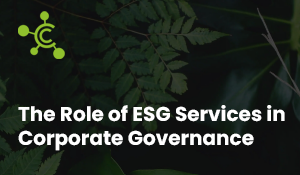Are you piecing together your ESG strategy puzzle? In the following paragraphs, we’re unveiling our four top tips for constructing a robust foundation for your strategy.
But what exactly is an ESG strategy? It’s the dynamic process of revealing data to transparently showcase an organisation’s performance across three crucial areas: environmental sustainability, social sustainability, and corporate governance.
Nowadays, investors are turning to ESG as their screening method for selecting investment-worthy companies and comprehending their portfolio companies. Consequently, more and more companies are crafting their own ESG reporting strategy. Environmental, social, and governance (ESG) factors are rapidly emerging as pivotal value drivers in investment decisions. A staggering 74% of the world’s largest investors are now prioritizing ESG investing, according to a recent edie report.
Organisations, regardless of size, are starting to feel the heat to chart out their ESG reporting strategy. While developing an ESG strategy may seem daunting and formidable, with the right arsenal of tools and practices, organisations can forge a strategy that not only supports risk management but also propels positive impact. In this electrifying blog, we’ve curated some of the most effective tips and tricks gleaned over the years to propel you toward success with your ESG strategy and underscore its significance.
But why exactly is ESG reporting so vital?
We’re in the midst of a climate emergency, where understanding environmental and social risks has skyrocketed in importance for investment decisions. ESG criteria have seamlessly woven themselves into the fabric of risk management, as they not only enable organisations to make a positive impact on the world but also have a tangible effect on the organisation itself.
For instance, it shifts the regulatory winds in your favour. As ESG regulations tighten, more investors are demanding ESG disclosure. Companies lacking an effective ESG reporting strategy risk missing out on lucrative business opportunities and exposing themselves to ESG risks. Instead of waiting until ESG reporting becomes mandatory, hop on the ESG train and reap its benefits, or better yet let us make it happen for you
Furthermore, an ESG strategy enables you to pinpoint vulnerabilities and risks before they burgeon into crises. ESG-related risks, such as extreme weather events and modern slavery in supply chains, loom large as some of the most pressing threats companies face. Astute organizations leverage ESG strategies to identify, mitigate, and address vulnerabilities before they spiral out of control. Plus, it slashes operational expenses. Robust ESG policies empower companies to drive more efficient and strategic resource allocation, thereby trimming operational expenses like energy, water, and waste costs.
Moreover, it shields your company from inadvertently greenwashing. Companies lacking pertinent ESG data, transparency, or focusing solely on the wrong aspects risk accusations of greenwashing. Adopting standardized ESG metrics can help companies sidestep this pitfall. It bolsters brand integrity by fostering transparency and, consequently, bolstering trust among investors, employees, and customers.
And lastly, it ensures your relevance in a rapidly evolving market. Today, the vast majority of modern businesses engage in some form of ESG reporting. Those that don’t risk falling behind and facing dire consequences, including loss of business, investors, and trust.
Now, onto the point of the matter: the best practices for constructing an ESG strategy!Firstly, assemble a dedicated ESG team. Many companies find themselves overwhelmed by the ever-expanding array of reporting frameworks, metrics, and legal requirements in the ESG landscape. While hiring a sustainability consultant might seem enticing, solely relying on external guidance impedes your organization’s ability to truly embed ESG into its DNA. A dedicated ESG team empowers the board to set goals, metrics, and targets, monitor progress, and future-proof the company. While the journey may be fraught with challenges initially, assembling the right team to spearhead your ESG goals is paramount. So, go ahead, recruit ESG experts or unearth talent already existing within the team!
Next, align with suitable global and regulatory frameworks. Once your dedicated ESG team is in place, the next step is to identify a suitable framework to align your reporting process. Utilizing a specific framework streamlines the reporting process by providing guidance on where to focus, what to measure, and how to communicate findings. Selecting the right reporting framework is more crucial than many realise. The plethora of frameworks and standards has opened the floodgates to greenwashing, as companies cherry-pick reporting systems that align with their interests. Often, organisations use their end goals as the starting point when deciding what to measure. However, the fundamental purpose of ESG is to measure an organization’s overall sustainability performance and unearth risks and opportunities that may initially go unnoticed. Failing to align your ESG strategy with an established framework tailored to your organization jeopardizes the quality of your data and, at worst, allows risky practices to slip through unnoticed.
Before we move on to the next key steps, check out how we perform our fully managed ESG service for businesses, or tune in on our Webinar to hear more about it.
So what constitutes the two remaining bits of your ESG strategy? Read all about it next week!




